#Canada India Tensions
Explore tagged Tumblr posts
Text
Canada-India tensions spark journey considerations amongst Indian diaspora - Nationwide Information Buzz
As tensions escalate between India and Canada, some within the Indian diaspora say they’re involved about how the state of affairs would possibly have an effect on journey between the 2 nations. The federal authorities expelled six Indian diplomats on Monday after the RCMP mentioned it had credible proof that Indian brokers performed a task in violent crimes on Canadian soil, together with…
0 notes
Text
'Ludicrous': MEA Dismisses Canadian Report Alleging PM Modi Was Aware Of Nijjar Murder Plot
The Ministry of External Affairs (MEA) on Wednesday strongly dismissed a Canadian report wherein the country’s official alleged that Prime Minister Narendra Modi was aware of a plot to kill pro-Khalistan separatist Hardeep Singh Nijjar in Canada. Calling the claims “ludicrous,” the MEA said such assertions further damage the already strained diplomatic ties between India and Canada. “We do not…
#Amit Shah#canada#Hardeep Singh Nijjar#India#india canada diplomatic row#India Canada Diplomatic Tensions#India Canada Tensions#Justin Trudeau#MEA#Narendra Modi#Nijjar Murder Case#Nijjar Murder Plot#Nijjar Row
0 notes
Text
Thanksgiving Reflections Amidst Canada-India Diplomatic Tensions
Thanksgiving Reflections and Diplomatic Tensions Thanksgiving in Canada has traditionally been a quieter affair compared to the grand family gatherings seen in the United States. In fact, in certain regions, such as Atlantic Canada, the holiday is not even recognized. This year, however, the holiday was overshadowed by grave political tensions stemming from a recent event. The assassination of…
#Canada#diplomatic tensions#expulsion of diplomats#foreign interference#Hardeep Singh Nijjar#India#international law#Prime Minister Justin Trudeau#R.C.M.P.#sovereignty#Thanksgiving
0 notes
Text
Canadian police say India collaborates with gangs to kill dissidents
Canadian police say India collaborates with gangs to kill dissidents #Canada-Indiatensions #HardeepSinghNijjar
#Canada-India tensions#Hardeep Singh Nijjar#Khalistan#Lawrence Bishnoi#organized crime#Sanjay Verma#targeted killings#transnational violence
0 notes
Link
Bombs R Us
#Canada#India#Khalistan#terrorism#Air India 182#unaccountability#crime haven#strategy of tension#open threats#Justin Trudeau
0 notes
Text
India-Canada Tensions Escalate: Allegations, Reactions, and the Khalistan Connection
Canada-India tensions have taken a dramatic turn, raising concerns on the international stage. The recent escalation stems from allegations made by Canadian Prime Minister Justin Trudeau, accusing Indian government agents of involvement in the killing of Canadian national Hardeep Singh Nijjar, who was declared the head of the Khalistani Tiger Force (KTF) in India. Here’s a detailed breakdown of…

View On WordPress
0 notes
Text
India and Canada: Tensions on the Rise: What's Happening and Why?
India and Canada have shared a longstanding relationship rooted in democratic values, pluralism, and strong interpersonal ties. However, recent years have seen strains in this relationship due to various political and diplomatic disputes. One significant factor contributing to these tensions is the Khalistan separatist movement, which seeks to establish an independent Sikh homeland in India and…

View On WordPress
1 note
·
View note
Text
Book Openings I Love
Deciding how to start your book is an important and daunting question. I put together a list of book openings I love- and what makes them so good- to help brainstorm.
If you have any you'd like to add, please do! Let's keep this post ongoing.
1) Percy Jackson and the Lightning Thief by Rick Riordan
Anyone who read this book as a kid will know exactly what I mean.
'The Lightning Thief' starts with a warning to the reader to stop reading the book immediately and believe whatever lies their parents have told them. Otherwise, 'they' might come for them.
An adult might roll their eyes at this, but as a kid, you believe it. You find yourself wondering if what you're reading is true. It makes you feel like you're a part of this story- even if you haven't realized it yet. So, as you read on, you might end up looking for the signs and clues that this world of Greek gods and monsters exists around you in real life. The lines between fiction and reality blur, if only for a little while, and you become immersed in the story, because on some level, you can't help but want it to be real.
It also leaves you feeling that by reading this, you're doing something forbidden- something dangerous. Exactly the kind of stuff that gets your heart racing as a kid.
2) Life of Pi by Yann Martel
Life of Pi is one of my favorite books of all time, and the beginning has a lot to do with it.
"This book was born as I was hungry. Let me explain."
The book begins with an author's note that's not exactly an author's note. It begins as any author's note might- the writer explains how his previous publication was a bust, and that he took a trip to India to reinvigorate his creativity as he tried to write a new book that ultimately sputtered and died. That was, until he met a man who promised to tell him a story that will make him believe in God. The man then told him to seek out the main character, who is alive, and living in Canada. When the author does, he agrees that his story is indeed a story to make one believe in God, and commits to writing it down as a book through the main character's point of view, only with the disclaimer "any inaccuracies or mistakes are mine."
As they follow this progression, because of the way it's all structured, there's a good chance the reader might find themselves asking "Wait, is this a true story?"
The answer is of course no, and anyone who's read through most of the book would probably figure that out easily. However, if you get to the ending, you realize the question "Is this a true story?" has significant implications for the story's themes- and that makes them all the more resonant.
TL;DR: Life of Pi's beginning does the same as The Lightning Thief's beginning, only in a less obvious way that's far more effective on adults.
3) One of Us is Lying by Karen M. McManus
The premise of "One of Us is Lying" is that someone killed a boy named Simon, and that the people in the room when it happened- who just so happen to be the four POV characters- are the main suspects. The book then starts off my immediately putting the reader in the scene where Simon dies.
Now I'm not sure if this is a common mystery novel set up (I haven't read enough of this genre to know), but it's an effective one. This has the effect of getting the reader engaged in the story right from the get-go. Instead of passively reading the chain of events, the people who picked up the book are already going to be searching in between the lines for any clues on 'who done it.'
But not only is the reader looking all the little details in the scene, but they're also going to be questioning the POV of the person narrating the chapter. From the very start of the story, the reader gets immersed in several levels of tension that hook them and carry them through the rest of the story.
4) The Giver by Lois Lowry
"It was almost December, and Jonas was beginning to be frightened. No. Wrong word, Jonas thought. Frightened meant that deep, sickening feeling of something terrible about to happen."
The first chapter begins with a scene of an aircraft flying overhead a peaceful community, and a child narrator who's overly careful about using the right words to describe things. The narrator's trait doesn't appear to be unique though- a quick flashback to a moment in his classroom shows that this tendency has been drilled into him, just as with any other kid. The reader immediately gets the sense that something is off. What that something is, though, is a bit harder to pin.
There doesn't seem to be anything nefarious going on, aside from maybe the mention of a citizen getting 'released' after the aircraft landed and everything calmed down. Only, later in that chapter, being 'released' gets mentioned twice again at his family dinner, as his parents discuss how their work went that day. But otherwise, the dinner seems to be a normal and mundane affair with an emotionally mature, functional family. Maybe a little too functional.
So, when Jonas decides that the feeling he's experiencing is 'apprehensive,' the readers start to feel that way too.
5) A Natural History of Dragons by Marie Brennan
The preface and first chapter of "A Natural History of Dragons" does a great job of introducing one of the series's greatest assets: its main character.
"One benefit of being an old woman now, and moreover one who has been called a "national treasure," is that there are very few who can tell me what I may and may not write."
In the preface of the book, we find out exaclty who the main character/narrator is: a famous Victorian-era woman and accomplished dragon scholar, who's too old to care about being a 'proper lady' anymore. What's more, she's writing a series of memoirs about her life to satisfy the many adoring fans who have been writing her letters in hopes of hearing about the juicy gossip of her famous expeditions.
The narration oozes with personality from the very beginning, and that's before we even get to meet any dragons. Following this introduction, we get to see where her passion for dragon studies began: collecting little dragon "sparklings" as a kid. While her fictional readers would know these little creatures as commonplace in her world, the actual readers don't, since this world is as new to us as it was to her as a child. As such, the reader gets to share in her childlike wonder, and gets excited by the promise to discover the secrets of dragons right along with her.
#creative writing#writing#writers of tumblr#writers on tumblr#writing community#novel writing#writerscommunity#book blog#bookblr#books#writing advice#on writing#writer stuff#writer#writeblr#long post#booklr#books and reading#reading
71 notes
·
View notes
Text
VANCOUVER, British Columbia (AP) — Canadian police said they arrested three suspects Friday in the slaying of a Sikh separatist leader last June that become the center of a diplomatic spat with India, and are investigating possible ties between the detainees and the Indian government.
Three Indian nationals in their 20s identified as Kamalpreet Singh, Karan Brar and Karampreet Singh were arrested in Edmonton, Alberta on Friday morning in the slaying of 45-year-old Hardeep Singh Nijjar by masked gunmen outside Vancouver, police said.
Canadian Prime Minister Justin Trudeau sparked a diplomatic feud with India in September when he said that there were “credible allegations” of Indian involvement in the slaying of Nijjar.
India had accused Nijjar of links to terrorism, but angrily denied involvement in the slaying. In response to the allegatio ns [sic], India told Canada last year to remove 41 of its 62 diplomats in the country. Tensions remain but have somewhat eased since. [...]
Continue Reading.
Tagging: @newsfromstolenland
34 notes
·
View notes
Text
history of HAIQIN | part X: modern era
------------------------------------------------------------------------------
date: october 12, 2024. I have a dialectical journal due on the 15 when fall break ends. actually gonna lose it.
------------------------------------------------------------------------------
The Modern Era (1980s-Present)
Modern Government & Diplomacy:
Global Influence
Neutrality as a Diplomatic Tool:
Haiqin has perfected the art of neutrality, using it not only to avoid military entanglements but to position itself as a diplomatic hub. The country plays a key role in mediating between powers in global conflicts, regional South Asian tensions, European and American issues, and East Asian territorial disagreements. Additionally, Haiqin has hosted negotiations between superpowers, ensuring peaceful resolutions in situations involving complex geopolitical rivalries. Haiqin’s neutral position allows it to act as a safe intermediary for humanitarian ceasefire agreements and non-governmental organizations.
International Organizations:
Haiqin’s representatives have held leadership positions in various international organizations, including serving on the United Nations Security Council as a non-permanent member multiple times. The nation is also part of organizations such as the International Monetary Fund (IMF) and World Bank, where it promotes policies on equitable economic growth and sustainable development. Haiqin spearheads climate change discussions, advocating for stronger emissions regulations and funding for green technology development in developing nations.
Membership in International Organizations:
Beyond the UN and WTO, Haiqin has also taken leadership roles in climate action groups such as the Paris Agreement coalition and environmental sustainability pacts. Its position in the OECD has allowed it to participate in policy-making around economic growth, sustainability, and international tax reform, using its influence to promote eco-friendly practices and digital innovations across borders.
Strategic Alliances:
Despite its neutrality, Haiqin has formed strategic alliances with nations such as Switzerland, Sweden, and Canada. These alliances are based on shared values of environmental sustainability, human rights, and technological innovation. These relationships have bolstered Haiqin’s influence in international environmental summits like COP, where it frequently serves as a mediator between major world powers. Even while neutral, they have one of the strongest militaries.
In recent years, Haiqin has strengthened ties with countries in Northern Europe, America, Japan, and South Korea, focusing on creating a global "Green Alliance" promoting renewable energy and sustainable industrial practices. Its strategic partnerships focus on technological innovation, intellectual property agreements, and knowledge exchange in science and education. These partnerships extend to cooperative space research initiatives, placing Haiqin at the forefront of cutting-edge satellite technology and space exploration.
The Military:
While Haiqin advocates for peace, it maintains one of the world’s most advanced and well-equipped military forces, particularly in the fields of cyber defense and intelligence. Haiqin’s military is recognized for its rigorous training in both conventional combat and modern cyber-warfare techniques. Specialized units focus on counter-terrorism, environmental protection, and strategic disaster responses. Military service remains voluntary but highly prestigious, with many youth aspiring to join due to the opportunities it offers in education, training, and post-service careers. Also many snipers are woman, so yeah.
Diplomacy & Neutrality
Mediation Efforts:
Haiqin's diplomats are often called upon to mediate some of the world's most complex conflicts. A notable instance was the 1998 Haiqin-brokered peace agreement between India and Pakistan over Kashmir, which brought about a temporary ceasefire and facilitated humanitarian aid in the region. Haiqin has also mediated North Korean and South Korean negotiations in partnership with international powers, reinforcing its role as a stabilizing force.
Bridge Between Cultures:
Cultural exchange remains a key strategy in Haiqin's diplomatic toolkit. The government sponsors international art exhibitions, theater tours, and music festivals to foster goodwill with other nations. Haiqin's rich blend of Greek and Native influences, along with its modern artistic contributions, gives it unique cultural appeal. Educational exchange programs have also blossomed, sending young Haiqin students to study abroad while welcoming international students into Haiqin universities.
Crisis Response:
Haiqin was among the first countries to offer medical and logistical aid to struggling nations. It shipped millions of units of personal protective equipment (PPE), ventilators, and vaccines to over 30 countries. This led to a boost in its global reputation as a humanitarian leader and reaffirmed its commitment to global health.
The government has established a rapid response team trained to deal with various crises, including natural disasters, refugee situations, and health emergencies, reflecting its commitment to global humanitarian efforts.
Cultural Diplomacy:
With Haiqin’s unique blend of Native and Greek heritage, the nation actively promotes its art, cuisine, and traditions across the globe. Through international festivals, Haiqin exports its cultural products while supporting collaborations in theater, dance, and film with major cultural centers in Paris, Tokyo, and New York.
Societal Changes:
Technology and Innovation
Renewable Energy Leadership:
In the 1990s, Haiqin underwent a massive transformation in its energy sector. Inspired by its cultural reverence for nature, the government launched the "Green Future Initiative," which sought to transform Haiqin into one of the most energy-efficient nations in the world. By 2010, Haiqin had achieved near-total reliance on renewable energy, with solar and wind farms scattered across the country’s landscapes. Hydroelectric dams tap into the nation’s many rivers, and cutting-edge geothermal plants have been established in the mountainous regions. Haiqin has also become a global exporter of green technologies, particularly in the development of low-cost, high-efficiency solar panels.
Haiqin’s innovation in renewable energy is unmatched. By 2030, it aims to power 90% of its domestic energy consumption through renewable sources. It has developed state-of-the-art solar farms and off-shore wind turbines, some of which are the largest in the world. The country exports its renewable energy technologies, helping nations transition to cleaner energy systems.
Environmental Protection Initiatives:
As part of its commitment to sustainability, Haiqin has established numerous protected areas, wildlife reserves, and national parks. These spaces not only conserve biodiversity but also reflect the nation’s ongoing effort to preserve the natural beauty that plays a central role in its identity. Government programs offer incentives for green businesses, and the country has enacted strict environmental laws aimed at minimizing pollution and encouraging ecological responsibility.
Education and Healthcare Investment:
The Haiqin government invests heavily in education and healthcare, aiming for a balanced society where citizens can thrive. Schools emphasize critical thinking, creativity, and emotional well-being, ensuring that students receive a holistic education that prepares them for the future.
Advancements in Bioengineering:
Haiqin’s universities are world-renowned for their research programs, especially in bioengineering, quantum computing, and artificial intelligence. Government incentives encourage collaboration between academic institutions and private companies, fostering an ecosystem where breakthrough technologies in medical science, especially regenerative medicine and bioprinting, are regularly produced.
Digital Media:
In the 2000s, Haiqin became a hub for digital innovation, particularly in the realms of film, music, and video game production. The country's tech scene flourished, with startups leading advances in artificial intelligence, virtual reality, and bioengineering. Many tech conglomerates now have headquarters in Haiqin, making it a focal point for digital media production globally.
In the 21st century, Haiqin emerged as a leading force in the digital media space. Homegrown tech firms have developed some of the most popular social media platforms, while the country's gaming industry has achieved global renown. Government-supported programs encourage innovation in tech and arts, leading to groundbreaking developments in virtual reality and digital art. Haiqin's startups frequently collaborate with international firms, cementing its reputation as a technological and creative powerhouse.
Technological Hub:
Haiqin’s cities, particularly Nirin and Pylos, have become vibrant hubs of technological innovation, earning the nickname "Silicon Valley." The government’s significant investment in education and technology in the 1980s paid off by the early 2000s, as startups and major tech companies began to flourish. Key sectors include bioengineering, artificial intelligence, renewable energy, and digital media. Collaboration between Haiqin’s universities and international institutions led to groundbreaking advances in biotechnology, with Haiqin becoming a leader in medical research and the development of genetically engineered crops that are now widely used across the globe.
Cultural Fusion
Architectural Harmony:
The modern cities of Haiqin reflect a seamless fusion of old and new. In the capital city of Stellis, ancient temples stand in harmony beside sleek, futuristic skyscrapers. Architects have paid homage to traditional styles, incorporating elements such as stone carvings, intricate mosaics, and decorative columns into modern buildings. In many urban developments, public spaces include green areas, drawing from both Native and Greek traditions that emphasize a deep connection to nature. This fusion is also seen in residential housing, with new eco-friendly technologies built into homes inspired by traditional Haiqin designs, featuring wide courtyards and terraced gardens.
Haiqin's cities reflect a fascinating combination of ultra-modern architecture and ancient influences. Towering glass skyscrapers are integrated with centuries-old buildings, blending Greek-inspired columns with traditional Native designs, creating an aesthetic harmony of old and new.
Cultural Integration:
Despite modernization, Haiqin remains deeply connected to its cultural roots. Festivals celebrating historical events and cultural milestones are widespread, with both rural and urban areas participating. Traditional music, dances, and rituals are commonly performed, keeping ancient customs alive. However, these celebrations have also embraced modern artistic forms, such as digital art and contemporary music. Art installations and interactive performances blending tradition and technology are a highlight of these festivals, illustrating the nation's ability to preserve its past while embracing the future.
Art and Music Scene:
Haiqin is home to a thriving creative arts scene. The government actively supports artists, musicians, filmmakers, and playwrights, making Haiqin a cultural hub that attracts global attention. Haiqin's film industry has produced several award-winning movies, often telling stories that draw from the nation’s mythology, history, and unique blending of cultural influences. Similarly, musicians from Haiqin are known for blending traditional instruments with modern sounds, creating a genre often referred to as "Neo-Classical Fusion." International music festivals held in Primos and Naidya attract thousands of artists and spectators each year, placing Haiqin on the world map for both traditional and contemporary artistic expression.
The Haiqin art scene has exploded in the digital age, with a new wave of artists creating interactive digital installations and virtual reality art. Music festivals like "The Resonance Festival" attract international artists and music lovers from around the globe, blending traditional Haiqinese music with modern genres like EDM and indie rock. This blend of traditional and contemporary is also seen in cinema, where Haiqin filmmakers are recognized at international film festivals for their innovative storytelling, merging mythological elements with modern themes.
Modern Society:
Cultural Identity and Pride
Preservation of Heritage:
In response to the rapid changes brought by globalization, Haiqin has doubled down on the preservation of its heritage. The government funds cultural preservation projects aimed at safeguarding the nation’s languages, art forms, and historical sites. Museums and cultural centers are abundant, and children are taught the nation’s history from a young age, fostering a deep sense of identity and pride in their cultural roots.
Pride in Heritage:
Haiqin's citizens take immense pride in their cultural heritage. Educational institutions emphasize the importance of local history, folklore, and traditional arts, ensuring that future generations remain connected to their roots. This cultural pride manifests in community events, where local artisans showcase their crafts and traditions.
Education and Family Values:
Haiqin's education system is widely regarded as one of the most progressive in the world, focusing not only on academic success but also on emotional well-being and creativity. The curriculum emphasizes critical thinking, global awareness, and environmental stewardship. Families play a vital role in the educational system, with parents heavily involved in their children’s academic lives. Traditional family values are emphasized alongside modern ideas of personal growth and mental health, creating a balanced approach to parenting.
Festivals and Community Celebrations:
Traditional festivals such as the “Harvest Moon Festival” and the “Festival of Winds” bring together Haiqin’s past and present. These events are occasions for the display of martial arts, traditional music, and culinary art. Contemporary cultural celebrations, such as film and music festivals, also play an important role, attracting international tourists and boosting local economies. Art exhibitions featuring both historical artifacts and modern creations are common, and these events foster community bonding while preserving cultural identity.
Military:
Veterans in Haiqin receive some of the most comprehensive benefits globally, ensuring they are well-supported in retirement and honored for their service. Many veterans transition into leadership roles in government, NGOs, and private sectors, particularly in industries related to security, disaster relief, or humanitarian work. The military also collaborates with civilian industries in developing technology for public use, fostering strong ties between the defense sector and national growth.
Artisans and Entertainment
Cultural Powerhouse:
The modern era has seen Haiqin's entertainment industry gain significant international acclaim. Musicians, filmmakers, and digital artists from Haiqin have made a global impact, often collaborating with foreign artists in cross-cultural projects. Festivals such as the Nirin Film Festival and the National Music Expo are renowned platforms for showcasing new talent and encouraging artistic exchange.
Festivals and Celebrations:
Haiqin has emerged as a cultural force in the world of entertainment. Its film industry, often referred to as "Haiqinwood," produces films that mix philosophical storytelling with visual mastery. These films often reflect the nation’s cultural diversity and moral neutrality, offering unique narratives on global issues.
Integration of Arts in Education:
Arts are woven into the very fabric of Haiqin’s education system, where schools offer specialized programs in music, theater, dance, and visual arts. This emphasis on creativity has resulted in a vibrant national arts scene, with young talents being nurtured from an early age and provided with platforms to showcase their work. Many schools encourage artistic collaboration, fostering the next generation of creative thinkers who will shape the cultural landscape of the nation.
The arts are not just a hobby in Haiqin—they are an integral part of the education system. From primary school to university, students are exposed to music, dance, theater, and visual arts, fostering creativity and cultural pride. This has led to the country producing internationally-renowned artists, filmmakers, and writers who continuously push the boundaries of their crafts.
Nonlethal Duels in Nirin
Hanging Crescent Moon Arena:
The Hanging Crescent Moon Arena is more than just a site for nonlethal duels—it has become a cultural icon. Every year, the nation hosts the “Crescent Games,” a series of competitions where participants display their mastery of traditional martial arts in non-lethal combat. These duels emphasize discipline, skill, and respect, celebrating the nation’s warrior roots while promoting nonviolence. The military units in Nirin also train in the arena for certain types of combat.
Cultural Significance:
Nonlethal dueling is more than just a sport; it is a cultural symbol of Haiqin’s values of fairness, discipline, and respect. Fighters wear traditional garb representing their regional and cultural backgrounds, and the duels themselves are often accompanied by ceremonial music and dancing. The competitions are a powerful reminder of Haiqin’s rich martial history, which has evolved into a peaceful and respected modern tradition.
−adding this since I'm probably scripting I'm from Nirin since this is the MOST I've put into any of the 10 provinces (blame my hyper fixation on GHOSTBLADE by WLOP)
#reality shifter#reality shifting#shiftblr#shifting community#shifting#shifting motivation#shifting reality#dr scrapbook#dr world#reyaint#anti shifters dni
8 notes
·
View notes
Text
India says it has 26 extradition requests pending with Canada - Nationwide Information Buzz
Descrease article font dimension Improve article font dimension India had at the very least 26 extradition requests pending with Canada, the South Asian nation’s overseas ministry mentioned on Thursday, amid a diplomatic row between the 2 nations. “These are over the past decade or extra,” India’s overseas ministry spokesperson Randhir Jaiswal instructed reporters throughout a weekly media…
0 notes
Text
HEY DO YOU KNOW ABOUT THE ASSASSINATION OF A PROMINENT SIKH LEADER IN CANADA AND WHY THIS MATTERS?
I generally don't like to write current events-y stuff here, but since I'm not seeing any people talking about this in my corner of this hellsite, I figured I might as well.
DISCLAIMER: For the record, I'm part Punjabi, raised culturally Sikh in the United States, I don't actively practice Sikhism, and I'm writing this assuming a non-Sikh, non-Desi audience that knows little to nothing about Indian politics. I am trying to be as factually accurate as possible but if certain information is incorrect, I will correct this post because a) this is an ongoing issue so the information I have right now may not turn out to be correct and b) my memory is fallible and while I did try to fact-check the background information I remembered, many of these historical events have accounts that differ drastically from each other, so it is difficult to establish a definite truth. This post was written and last updated 25 September 2023.
So, the basic facts of what happened:
Hardeep Singh Nijjar was killed on 18 June 2023. He was a proponent of the Khalistan movement. In the past week or so, Canadian government officials have accused India of orchestrating his assassination.
Khalistan? What's That and Why Does It Matter?
Like quite a few things in Desi politics, the idea of Khalistan can be traced back to the Partition. At the heart of the Partition, the idea was that Pakistan is for the Muslims and India is for the Hindus.
However, India is not exclusively populated by Hindus, no matter how hard Modi and the BJP* try to make it a Hindu-only nation through their Hindu nationalist policies. Among other religious minority groups, many Sikhs had to made the new India their home, because of the religious persecution they would face in Pakistan. The Radcliffe Line (the line of partition) runs right through Punjab, the ancestral homeland of, among others, most Sikhs. In Punjab, during the Partition, Hindus, Sikhs, and Muslims carried out sectarian violence against each other.
What this means is that a lot of Sikhs were displace from their homeland and subjected to discrimination and violence based on their religion in both Pakistan and India. As a result, some members of the Sikh community started calling for a new nation to be carved out of the Punjab regions in Pakistan and India. This new nation was to be a Sikh nation, much like Pakistan for the Muslims and India for the Hindus, and it was to be called Khalistan.
(Little bit of anecdotal trivia: apparently identifying as Punjabi first and Indian second when describing ethnic background is more common among Punjabi Sikhs, due to Sikh efforts to show their connection to Punjabi in an attempt to make Khalistan a Sikh nation in the Punjabi region.)
Needless to say, the Indian government did not and does not like the idea of a Sikh nation and sees the idea of it as a terrorist threat.
*Bharatiya Janata Party, the Hindu nationalist party currently ruling over most of India.
Operation Blue Star and Indira Gandhi
As part of this rising call for a Sikh nation, Sikh militant groups sprung up. Indira Gandhi's government wanted to arrest one of the most prominent leaders of a Sikh militant movement. However, he and his supporters were holed up in the holiest site in Sikhism, the Golden Temple in Amritsar.
On one of the holiest days in Sikhism, the martyrdom day of Guru Arjan Dev, the Indian military began their attack on the Golden Temple, known as Operation Blue Star. Long story short, Sikh pilgrims were killed during both the fighting and in extrajudicial killings by the military afterwards.
In anger at how Gandhi's government had carried out Operation Blue Star, two of her Sikh bodyguards assassinated her. Anti-Sikh pogroms then occurred, with independent estimates of the number of Sikhs killed ranging from 8,000 to 17,000.
This only made tensions between the Sikh community and the Indian government worse; I see this as a defining moment in how the government of India responds to the Khalistan movement and both Sikh extremist violence and peaceful support.
Oh and did I mention yet that the Indian government has outlawed the Khalistan movement?
The law that does this dates back to 1967, by the way.
Hardeep Singh Nijjar
And so now we come to the story of the recently-assassinated Hardeep Singh Nijjar.
Due to Khalistani activism being outlawed in India, many Khalistani activists have settled abroad. This includes Nijjar, who became a Canadian citizen in 2007 and had first come to Canada to apply for asylum after having been arrested by the Indian police in connection with his pro-Khalistan stance. He continued his Sikh and Khalistani activism in Canada until he was killed in the parking lot of the gurdwara he belonged to by two masked gunmen.
The Canadian government recently alleged that the Indian government war involved in the killing of Nijjar, but has not yet provided firm evidence.
Why Does This Matter?
Obviously, as a culturally Sikh person, it matters to me because this assassination is part of a legacy of violence targeting my community due to perceived associations with terrorism. (Yes, there are some Sikh extremists and terrorists, but the overwhelming majority of Sikhs are neither extremists nor terrorists.)
But this has ramifications that everyone should care about.
Canada and India have recently done tit-for-tat diplomatic expulsions due to the Canadian government's allegations
The US may also get dragged into this because Canada alleged that American intelligence gave them some information necessary to prove the involvement of the India government
The UK may also get dragged into this because they, too, have a sizeable Punjabi Sikh community that includes multiple MPs and the government has historically had strong relationships with both Canada and India
Despite the BJP's involvement in anti-Muslim violence, Modi and his government still enjoy a cozy relationship with many Western nations; this may start to change, although change is unlikely as Western governments see being allied with India as key to countering Chinese influence
If India is proven to be behind the assassination, this could be bad for other Khalistani activists in the Sikh diaspora because it means the Indian government could potentially target and kill them, too
This is important. Injustice anywhere is a threat to justice everywhere, and this isn't an isolated incident. I know I probably didn't do a great job explaining this, but it's hard to summarize about 550 years of oppression and violence and politics and culture and how that has manifested over the past 80 years, leading to the murder of a prominent leader in the Sikh diaspora.
For further reading on this, I'd suggest this BBC article, which includes information on some other Khalistani activists recently killed.
Anyhow, I'll keep trying to follow the news on this and update this post as needed, likely through reblogs.
#current events#sikhism#religion#khalistan#canada#india#hardeep singh nijjar#look i really don't like to write politics and current events shit#but it's important to me to just put this out in the hopes that more people hear about this and also understand what it means#i tried to keep this short so there's a lot i left out
41 notes
·
View notes
Text
Geopolitical Tensions: Canada Accuses India of Assassination Plot Against Sikhs
Geopolitical Intrigue Surrounding Canada and India In a week marked by significant geopolitical tensions, Canada escalated its accusations against India, alleging that the Indian government was involved in a plot to assassinate Sikh citizens on Canadian soil. This situation unfolded alongside the United States providing evidence in a related case, creating a complex diplomatic landscape. Two…
#assassination plot#Bharat Karnad#Canada#diplomatic relations#diplomats expelled#geopolitical tensions#India#Justin Trudeau#Narendra Modi#national security#Sikh citizens#U.S. cooperation
0 notes
Text
How relations between India and Canada reached rock bottom
How relations between India and Canada reached rock bottom #bilateraltrade #diaspora #DiplomaticTensions
#bilateral trade#diaspora#Diplomatic Tensions#Hardeep Singh Nijjar#India-Canada relations#Justin Trudeau#Khalistan#Sikh separatism
0 notes
Link
Playing colonial games
#Canada#India#Khalistan#terrorism#foreign interference#Justin Trudeau#Jagmeet Singh#strategy of tension#assassination#colonialism
0 notes
Text
The Day of Days: Eighty Years After
It was a brisk summer night, almost like any other June night in England.
The terror of the Blitz was long over. Four years ago, the Battle of Britain long had been won. Two years ago in the Pacific the Americans had shocked the world with impossible victories at Midway and Guadalcanal. A year ago, the last German forces had surrendered in North Africa, and the Communists of the Soviet Union had done the impossible and stopped the German war machine in its tracks at the gates of Stalingrad and Moscow before, finally, turning the tide at Kursk. A month early the British Army in India had stopped the Imperial Japanese Army in its tracks at Kohima Ridge, and for the first time in three years the Japanese were on the run. Just a day before, the American Fifth Army had liberated Rome, freeing the "Eternal City" from fascism after twenty years.
They were winning - just. The war was still going on, ever-present in their minds, but they could sleep soundly under a quiet, friendly sky.
But in the dark, in army camps and airfields and naval bases and offices across the southwest of England, the scene was very different. Men whispered to each other, prayers and jokes, trying to lighten the tension in the air, so thick they could cut it with a knife. John Ford - the famed Hollywood director turned Navy Field Photographic unit captain - supposedly told his wife he was going off for a little local skirmish. And in his private office, Dwight D. Eisenhower - Commander, Supreme Headquarters Allied Expeditionary Force - typed the resignation he hoped he'd never have to give. If the unthinkable happened, if this gamble failed...they might never get another chance.
All at once, all across the southwest of England, just before midnight, the quiet was shattered by the roar of thousands upon thousands of piston engines, and thousands of men, some barely out of high school, clambered aboard planes and landing craft for a journey into the dark.
Eisenhower penned a short note, and ensured that a copy was given to every single one of the men under his command. It read, very simply:
"You are about to embark upon the Great Crusade, toward which we have striven these many months. The eyes of the world are upon you. The hopes and prayers of liberty-loving people everywhere march with you. In company with our brave Allies and brothers-in-arms on other Fronts, you will bring about the destruction of the German war machine, the elimination of Nazi tyranny over the oppressed peoples of Europe, and security for ourselves in a free world."
It was June 6th, 1944, and after three years of begging by Josef Stalin, and a year of intense planning, brutal training, unparalleled deception, and massive buildup, the time had come to do the impossible.
The Allies were going to break the Atlantic Wall, or die trying.
It was a herculean task. The Germans had spent four years preparing for just this day, filling every beach from Cherbourg to Amsterdam with every kind of mine imaginable, dotting Czech hedgehogs and wooden posts tipped with high explosives along the shallow coastlines, and building bunkers with encased machine guns and artillery, pre-sighting mortars and artillery, digging trenches and building tens of thousands of pillboxes, and digging enough anti-aircraft positions to turn night into day. In command was Erwin Rommel, the famed "Desert Fox", a veteran of the brutal World War I Italian front, and one of the best tank commanders in the world who had fought across France and North Africa. Under his command were almost half a million German troops, including battle hardened veterans of France, Africa, and Russia.
Standing against them, over a thousand planes and gliders carrying over 23,000 paratroopers from the United States, the United Kingdom, and Canada. Behind them, thousands of fighters and bombers and almost seven thousand landing craft and ships carrying more than 160,000 men from thirteen nations.
The Day of Days began just after midnight.
At 00:48 on June 6th, 1944, the men of the 101st Airborne became the first of to make a terrifying jump into the dark.
It was the beginning of the single largest amphibious invasion ever attempted. Six hours after the paratroopers took the plunge, at 06:30 local time, the first men stumbled onto shore, and into the jaws of death.

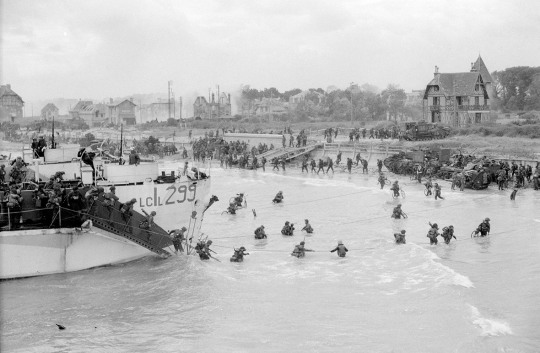
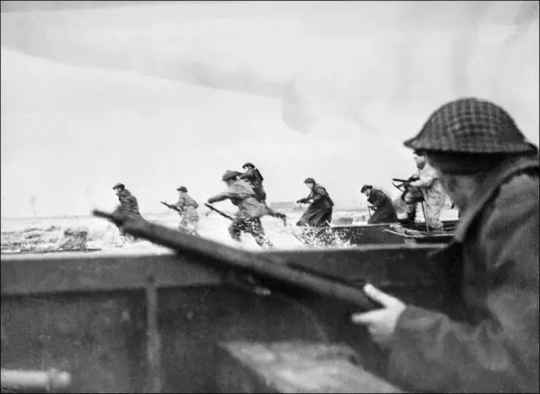
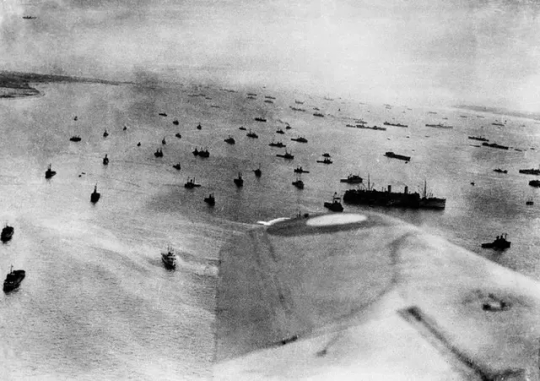
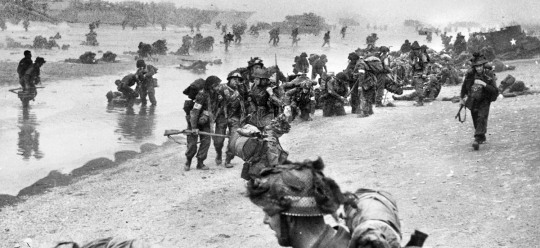
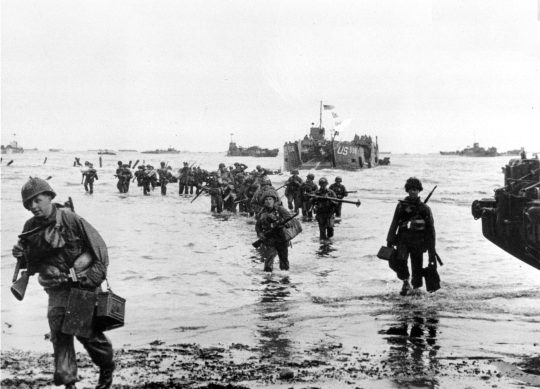
Almost immediately, the entire plan fell apart. Fog, cloud cover, a lack of navigators, and brutal anti-aircraft fire forced many pilots to signal the paratroopers to drop outside their assigned zones, mixing units and men and causing absolute chaos on the ground. The weather in the channel was not much better: high seas swamped many of the landing craft and amphibious tanks, and strong currents pushed entire regiments out of their landing zones.
When the men finally made it to the beach, they faced a desperate run across the dreaded shingle: a nearly half-mile expanse of open sand and rock, with no protection at all from the waiting German defenders. Their fire support - the naval vessels waiting offshore, bristling with guns of all calibers - was of little help; the captains refused to close any farther than the extreme ranges for fear of counter fire. And the bad weather in the skies above prevented pilots from accurate close air support.
Over ten thousand men from both sides would have their lives ripped apart on beaches in just that first day.
On Omaha Beach alone, almost two thousand men were killed. Some didn't even get a chance to face the enemy - instead, they simply drowned, their heavy equipment weighing them down into the cold waters of the North Atlantic. The beaches themselves, its said, turned red with blood as men were killed by the dozen. At Gold, Juno, and Sword Beaches, the Canadians and British managed to make it off the beach, only to be forced into fortified towns, where they endured the brutality and chaos of house-to-house urban warfare. At Pointe du Hoc, between Omaha and Utah Beach, the U.S. 2nd Ranger Battalion were forced to scale a one hundred foot cliff under withering enemy fire, only to become totally cut off. When they were finally relieved after two days, only 65 of the original 200 men were left standing, and they were forced to use captured German weapons as theirs ran out of ammunition, resulting in some of their number being killed due to friendly fire.
The paratroopers faired even worse - of the more than 20,000 American paratroopers and aircrew who made the desperate flight across the Channel, it's estimated that more than twelve thousand were killed.
The carnage was unlike anything anyone in the Allied forces had seen before, unlike Operation Torch or El Alamein in North Africa, unlike the Miracle of Dunkirk or the Battle of Britain, unlike Guadalcanal and New Guinea, unlike Salerno, Anzio, and Sicily.
For this untold sacrifice, this bloody hell that almost two hundred thousand men endured, they had only managed to capture a few square miles, only two of five beaches were connected, and they had failed to capture a single major city or port. The Allies failed to achieve even one of their major objectives - save one.
After five years of war, the Allies had a foothold.
The mother of all Hail Mary's had worked.
By the end of D-Day, almost 160,000 men had crossed the Channel into Fortress Europe.
On D+6, the beaches were finally connected.
On D+7, the city of Carentan was freed by the 101st Airborne, the first major French town to be liberated.
By D+20, the port city of Cherbourg was taken, and the Cotentin Peninsula was free after four long years.
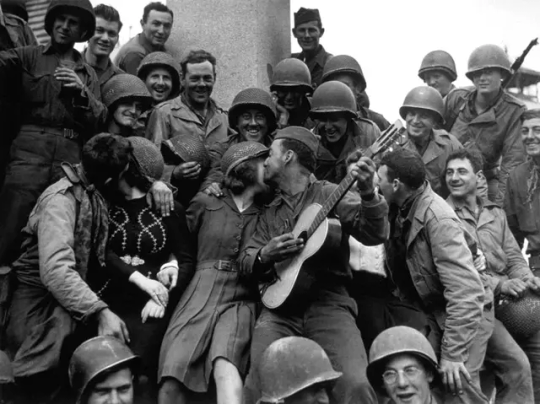
On D+50, the city of Caen was freed, and the objectives of D-Day had finally been completed. By this time, more than 1.5 million men from 15 nations had landed in Europe.
On D+70, the Allies landed on the beaches of Côte d'Azur, and in only four weeks broke the southern German front line, and liberated the entire south of France.
On D+76, the Falaise Pocket collapsed, and the Battle of Normandy was finally declared over in a resounding Allied victory.
Then, at long last, on D+80, General der Infanterie Dietrich von Cholitz, at 3:30 PM local time, surrended the city of Paris to General Phillipe Leclerc. After four years of occupation, the first Allied capital was free. The footage of that day has been called some of the most thrilling and ecstatic footage in history.
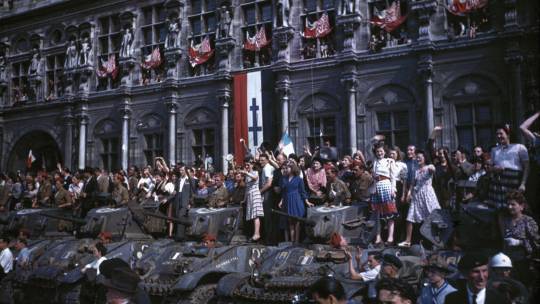
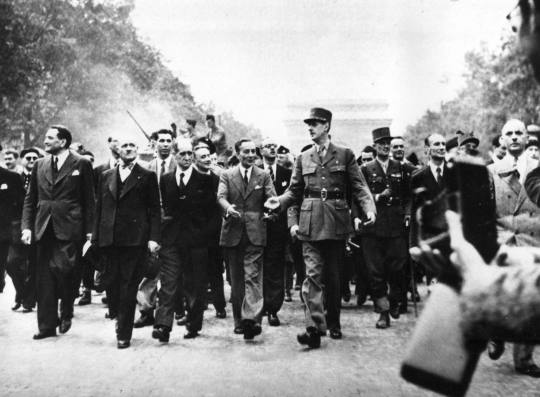
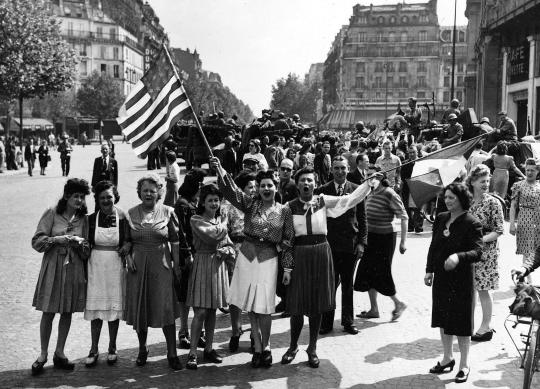

The march continued, and on D+89, the Welsh Guards marched into the Belgian capital of Brussels.
But the war was far from over - on D+193, the Wehrmacht launched Operation Nordwind; the Battle of the Bulge had begun. It would be Germany's last offensive, at the cost of hundreds of thousands of lives.
On D+274, the Allies crossed the Rhine, and liberated the Netherlands, and then finally entered Germany.
On D+303, the U.S. 4th Armored Division stumbled upon a scene of unimaginable cruelty: it was a camp named Ohrdruf, part of the Buchenwald complex, the first concentration camp to be liberated by the United States. Allied intelligence services had long suspected what was going on, that their were camps across Europe for Hitler's "undesirables", and the Allies had even signed a declaration making public and condemning the killing of Jews in Poland, but no one was prepared to see the true scale of the atrocities. Eisenhower demanded that every single piece of the camp be photographed, videotaped, and documented, that everyone possible be brought to see it to impress upon them the reality of what the Germans had done. Hollywood director George Stevens was given the task of making movies describing the horrors of the Holocaust, movies that were later shown to the world at the Nuremberg Trials. The movies were said to be the moment that changed the course of the Nuremberg Trials.
Then, on April 30th, 1945 - three-hundred and twenty eight days after the 'Longest Day' - Adolf Hitler, the man who had been the head of so much destruction, who had started the most destructive war in human history and presided over the worst genocide mankind has ever perpetrated, commits suicide in a bunker in Berlin.
Three days later, on May 2nd, 1945, the surrender of German Army Group C goes into effect, and the Gothic Line that had long since stymied the Allied advance in Italy finally collapses.
And on D+336, eleven months after landing on the beaches of France, Field Marshal Wilhelm Keitel would sign the German Instrument of Surrender, and the German Wehrmacht laid down its arms.
The Reich that Adolf Hitler had once boasted would last for a thousand years had fallen after just twelve.
The War in Europe was over.




Eleven months after he wrote it, the promise Eisenhower made to his men - the destruction of the German Army, the end of Nazi tyranny in Europe - had finally come true.
It had been five and a half long, blood-soaked years since the war in Europe began, but at long last, Europe was free. It would takes years, even decades, to rebuild from the destruction, but finally, there was a tomorrow to live for.
Eighty years on, we still grapple with their sacrifice, and the choices they made afterwards in the world they built. But because of them, we were given a tomorrow to argue in - and a tomorrow to live for. All because thousands from across the world stepped onto a small, windswept beach, and seared the name of Normandy into history.

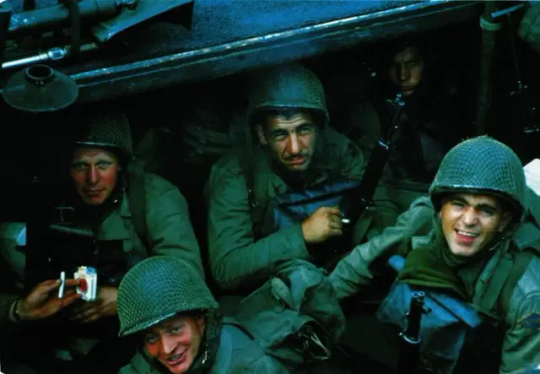


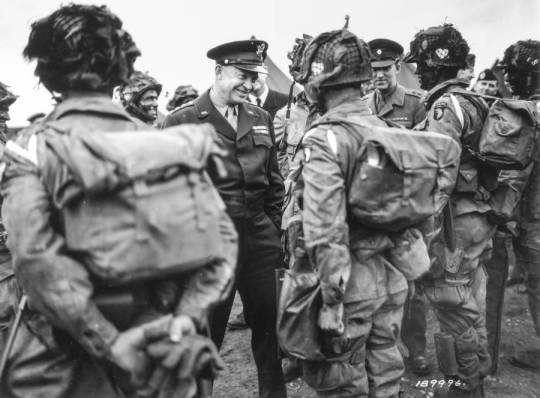
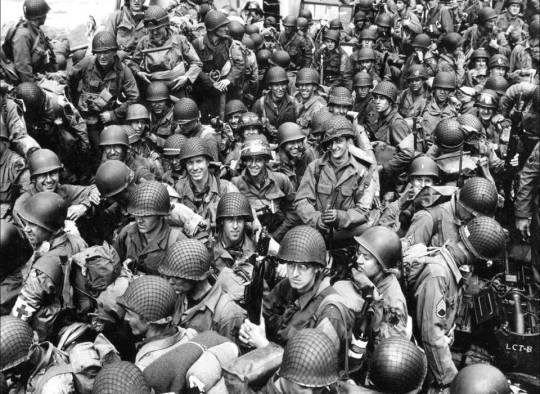

#history#ww2#d day#normandy#tw death mention#will anyone on tumblr care about this? doubtful#but i wrote it anyways because it's been 80 years and that has decided to occupy all of my writing brain cells
8 notes
·
View notes